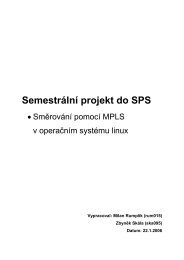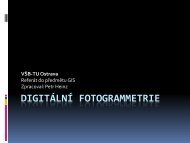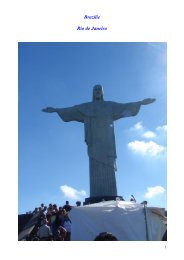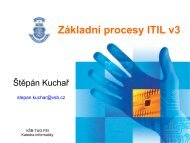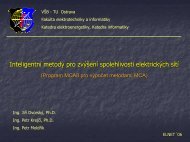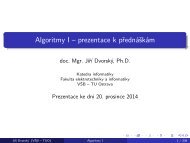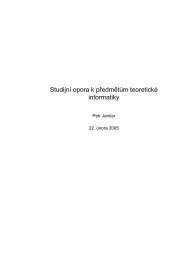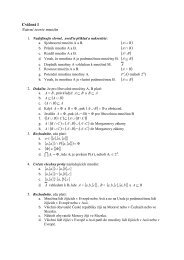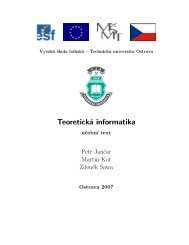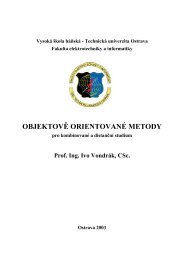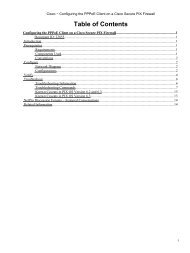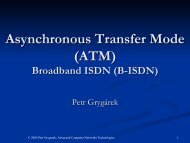Using Virtual Texturing to Handle Massive Texture Data
Using Virtual Texturing to Handle Massive Texture Data
Using Virtual Texturing to Handle Massive Texture Data
- No tags were found...
Create successful ePaper yourself
Turn your PDF publications into a flip-book with our unique Google optimized e-Paper software.
<strong>Using</strong> <strong>Virtual</strong> <strong>Texturing</strong> <strong>to</strong> <strong>Handle</strong> <strong>Massive</strong><strong>Texture</strong> <strong>Data</strong>San Jose Convention Center - Room A1 | Tuesday, September, 21st, 14:00 - 14:50J.M.P. Van Waveren – id SoftwareEvan Hart – NVIDIA
How we describe our environment ?• Polygonal boundary representations— convenient / compressed description of the material world• Tiling / repeating / blending textures— primitive forms of texture compression ?
Today• Polygonal boundary representations— convenient / compressed description of the material world• Tiling / repeating / blending textures— primitive forms of texture compression ?
Tonight ?• Polygonal boundary representations— convenient / compressed description of the material world• Tiling / repeating / blending textures— primitive forms of texture compression ?
Unique texture detail
Very large textures
<strong>Virtual</strong> <strong>Texture</strong> vs. <strong>Virtual</strong> Memory• fall back <strong>to</strong> blurrier data without stalling execution• lossy compression is perfectly acceptable
Universally applied virtual textures
<strong>Virtual</strong> textures with virtual pages
Physical texture with physical pages
<strong>Virtual</strong> <strong>to</strong> Physical Translation
<strong>Virtual</strong> <strong>to</strong> Physical Translation
<strong>Virtual</strong> <strong>to</strong> Physical Translation
<strong>Virtual</strong> <strong>to</strong> Physical Translation
<strong>Virtual</strong> <strong>to</strong> Physical Translation
<strong>Virtual</strong> <strong>to</strong> Physical Translation
<strong>Virtual</strong> <strong>to</strong> Physical Translation
<strong>Virtual</strong> <strong>to</strong> Physical Translation
<strong>Virtual</strong> <strong>to</strong> Physical Translation
<strong>Virtual</strong> <strong>to</strong> Physical Translation
<strong>Virtual</strong> <strong>to</strong> Physical Translation
<strong>Virtual</strong> <strong>to</strong> Physical Translation
Optimized virtual <strong>to</strong> physical translations• S<strong>to</strong>re complete quad-tree as a mip-mapped texture— FP32x4• Use a mapping texture <strong>to</strong> s<strong>to</strong>re the scale and bias— 8:8 + FP32x4• Calculate the scale and bias in a fragment program— 8:8:8:8— 5:6:5
<strong>Texture</strong> Filtering• Bilinear filtering without borders• Bilinear filtering with borders• Trilinear filtering (mip mapped vs. two translations)• Anisotropic filtering— 4-texel border (max aniso= 4)— explicit derivatives + TXD (texgrad)— implicit derivatives works surprisingly well
Which pages need <strong>to</strong> be resident?• Feedback rendering— separate rendering pass— or combined with depth pass— fac<strong>to</strong>r 10 smaller is ok• Feedback analysis— run as parallel job on CPU— run on the GPU— ~ .5 msec on CPU for 80 x 60
How <strong>to</strong> s<strong>to</strong>re huge textures?• diffuse + specular + normal + alpha + power = 10 channels— 128k x 128k x 3 x 8-bit RGBA = 256 GigaBytes— DXT compressed (1 x DXT1 + 2 x DXT5) = 53 GigaBytes• use brute force scene visibility <strong>to</strong> throw away data— down <strong>to</strong> 20 – 50 GigaBytes uncompressed— 4 – 10 GigaBytes DXT compressed
Need variable bit rate compression!• DCT-based compression— 300 – 800 MB• HD-Pho<strong>to</strong> compression— 170 – 450 MB
What does this look like per page?• 128 x 128 texels per page— 120 x 120 payload + 4 texel border on all sides— 192 kB uncompressed— 40 kB DXT compressed— 1 – 6 kB DCT-based or HD-Pho<strong>to</strong> compressed
Can’t render from variable bit rate• Transcode DCT-based or HD-Pho<strong>to</strong> <strong>to</strong> DXT— Significant computational load— 1 <strong>to</strong> 2 milliseconds per page on a single CPU core
Pipeline overview
GPU Transcoding Motivation• Transcode rate tied <strong>to</strong> quality / performance– Drop frames - Image is lower detail– Wait for results – frame rate degrades• Densely occluded environment may desire in excess of 46MTex/s• DCT-based transcoding can exceed 20 ms per frame• HD-Pho<strong>to</strong> transcoding can exceed 50 ms per frame
Transcoding Analysis• Several jobs (pages) per frame• Jobs occur in several stages– Entropy decode– Dequantization– Frequency transform– Color space transformation– DXT compression
Transcoding PipelineEntropy Decode(~20-25%)Frequency Transform(25-50%)DXT Compression(25-50%)
Transcoding Breakdown• Entropy Decode– 20-25% CPU time• Dequantization + Frequency transform– 25-50% CPU time• Color transform + DXT compression– 25-50% CPU time
Transcoding Parallelism• Entropy Decode– Semi-parallel, dozens <strong>to</strong> hundreds• Dequantization + Frequency transform– Extremely parallel, hundreds <strong>to</strong> thousands• Color transform + DXT compression– Extremely parallel, hundreds <strong>to</strong> thousands
Entropy Decode• Huffman based coding schemes– Variable bit-width symbol– Run-length encoding• Serial dependencies in bit stream• Substantial amount of branching
Huffman Decode BasicsBitstreamPosition
Huffman Decode BasicsBitstreamUnique prefixPositionOutput Symbol+Run-length info
Huffman Decode BasicsBitstreamPosition
Huffman GPU Processing• Long serial dependencies limit parallelism• Relatively branchy (divergence)• Relatively few threads• Can perform reasonably with very many smallstreams– Not the case here• CPU offers better efficiency <strong>to</strong>day
Frequency Transform• Block-based transform from frequency domain• iDCT of macro blocks– Inherently parallel at the block level– Uses NVPP derived iDCT kernel <strong>to</strong> batch severalblocks in<strong>to</strong> a single CTA– Shared memory allows CTA <strong>to</strong> efficiently transitionfrom vertical <strong>to</strong> horizontal phase
16 texelsMacroblock16 texelsLuminance8Chrominance= + +• Image broken in<strong>to</strong> macro blocks– 16x16 for DCT with color encoded as 4:2:0– Blocks are 8x8
CUDA iDCT• 2D iDCT is separable– 8x8 block has two stages 8-way parallel– Too little parallelism for a single CTA• Luminance and Chrominance blocks may requiredifferent quantization• Group 16 blocks in<strong>to</strong> a single CTA– S<strong>to</strong>re blocks in shared memory <strong>to</strong> enable fastredistribution between vertical and horizontal phase
iDCT Workload• 64 Macroblocks per 128x128 RGB page• 6 Blocks per macroblock (4 lum. + 2 chroma)• 8 Threads per block• 3072 Threads per RGB page– Fills roughly 1/5 th of the GTX 480
DXT Compression• DXT relies on 4x4 blocks– 1024 blocks in one 128x128 image• Thread per block works well– There is finer parallelism, but communication can be<strong>to</strong>o much– Careful packing of data useful <strong>to</strong> prevent registerbloat
DXT Blocks• 4x4 texel block• Min color, Max color, and 16 2-bit indicesMax Color (16 bit)Min Color (16 bit)Indices (32 bits)
CUDA DXT Compression• All operations performed on integer colors– Matches CPU reference implementation– Allows packing of 4 colors in<strong>to</strong> a 32-bit word• 4x better register utilization• CTA is aligned <strong>to</strong> Macroblock boundaries– Allows fetch of 4:2:0 data <strong>to</strong> shared memory forefficient memory utilization• Presently 32x32 texel region
Putting it Together• CPU Entropy Decode needs <strong>to</strong> work on large blocks– Dozens of tasks per frame• GPU kernels desire larger sets– All pages as a single kernel launch is best for utilization– Parameters, like quantization level and final format, can varyper page• Must get data <strong>to</strong> the GPU efficiently
Solution CPU-side• CPU task handles entropy decode directly <strong>to</strong>locked system memory• CPU task generates tasklets for the GPU– Small job headers describing the offset andparameters for a single CTA task
Solution GPU-Side• Tasks broken in<strong>to</strong> two natural kernels– Frequency transform– DXT compression• Kernels read one header per CTA <strong>to</strong> guide work– Offset <strong>to</strong> input / result– Quantization table <strong>to</strong> use– Compression format (diffuse or normal/specular)
One more thing• CPU -> GPU bandwidth can be an issue– Solution 1• Stage copies <strong>to</strong> happen in parallel with computation• Forces an extra frame of latency– Solution 2• Utilize zero copy and have frequency transform read fromCPU• Allows further bandwidth optimization
Split Entropy Decode• Huffman coding for DCT typically truncates thecoefficient matrix• CPU decode can prepend a length and packmultiple matrices <strong>to</strong>gether• GPU fetches a block of data, and uses matrixlengths <strong>to</strong> decode run-length packing• Can easily save 50% of bandwidth
Run Length Decode• Fetch data from system mem in<strong>to</strong> shared mem• Read first element as length• If threadIdx < 64 and threadIdx < length copy• Advance pointer• Refill shared memory if below low water mark• Repeat for all blocks
Results• CPU performance increase– from 20+ ms (Core i7)– down <strong>to</strong> ~4 ms (Core i7)• GPU costs– < 3ms (GTS 450)• Better image quality and/or better frame rate– Particularly on moderate (2-4 core CPUs)
Conclusions• <strong>Virtual</strong> <strong>Texturing</strong> offers a good method forhandling large datasets• <strong>Virtual</strong> texturing can benefit from GPU offload• GPU can provide a 4x improvement resulting inbetter image quality
Thanksid SoftwareNVIDIA Devtech



